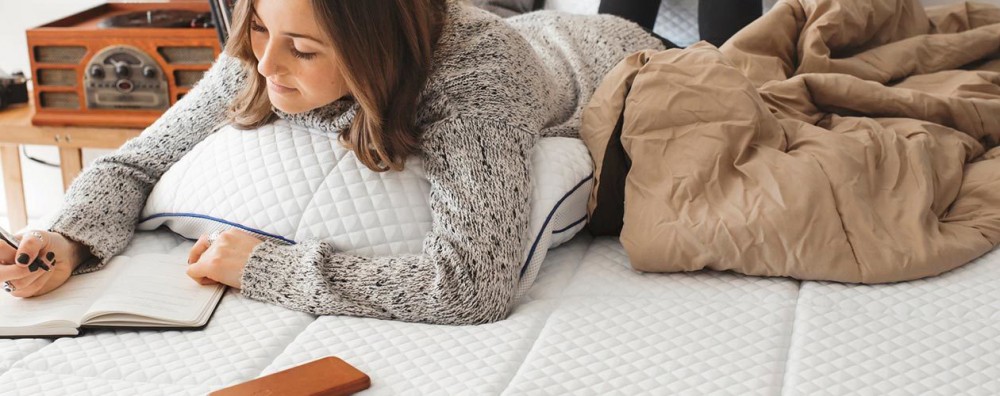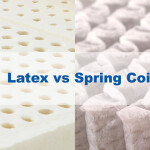Memory Foam vs. Innerspring Mattress
Your mattress has given up the ghost. It was probably a hand-me-down from your parents or your aunt, right? It served you well through your first apartment and your first job, but now it’s a sagging mess.
data-ad-client="ca-pub-1542090382626399"
data-ad-slot="7742579998">
Let it go.
Your new mattress will give you better sleep, help remove pressure points, and allow your spine to decompress. You won’t toss and turn looking for a comfortable spot anymore. We won’t say it will transform your life (because only you can do that) but it will remove a common problem for getting things done, fatigue.
A lot of people say memory foam is the only way to go for a new mattress, but with advances in mattress technology, you may not have to give up your beloved innerspring.
We’ve got a comparison of memory foam and spring mattresses to help you decide which type might suit your better. Let’s break it all down.
Construction
Let’s look at the basic construction of memory foam and spring mattresses first. Modern mattresses use a system of contouring and supporting layers to create better beds. Conventional mattresses only had firm support layers but very little contouring, making you feel like your body was conforming to the surface of the mattress. Translation? They weren’t very comfortable.
If conventional mattresses weren’t firm, they sagged a lot, especially around the middle. They cause a lot of back pain as your spine wasn’t supported properly.
Modern mattresses use a system of contouring and supporting layers to alleviate this issue. The top layer or layers are softer, helping cradle your curves without forcing your body to conform to the mattress. Underneath, dense support layers push back against your weight, so your spine stays straight, and you don’t experience sagging.
So how does each type of bed do this? It’s the same concept, but different execution.
Memory Foam
Memory foam mattresses use several different layers to create the bed. The top layers are usually softer than the bottom layers. They allow your broadest points to sink further into the mattress while filling in gaps around your waist and lower lumbar area. They’re often open cell or gel-infused to help improve airflow and regulate your temperature.
The layers underneath are denser, heavier foam. This foam pushes back against your body so that when your curves go through the contouring layer, you don’t sink all the way through. Instead, your spine remains straight because your body can’t compress the support foam.
The number of layers varies widely, but the minimum number of layers is two, a contouring layer and a support layer. More layers aren’t automatically better, and sometimes it depends on your personal preference.
Spring
Modern spring mattresses work the same way. The top layer is some sort of contouring layer. Many modern spring mattresses use memory foam (though a smaller layer than their hybrid cousins) to help cushion the body from the springs, but pillow top and Eurotop mattresses can use a variety of materials for cushion.
Most of the contouring and support come from the springs themselves. In place of dense foam, the coil layer pushes back against the body to prevent you from sinking too far into the mattress.
Most modern spring mattresses use pocketed coils instead of the interlocking coils of old mattresses. Pocketed coils all act independently, so they can better conform to your body shape. The coils underneath your shoulders compress more heavily than those at your waist, helping keep your spine straight.
In most cases, the higher number of coils means more contouring. You should also check the quality of the contouring materials. If they aren’t good, you’re going to interact more fully with the coils, which can still be uncomfortable.
Edge Support
What does contemplating your life and tying your shoes have in common? You’re probably sitting on the edge of the bed performing both. If your bed has good edge support, there’s minimal compression on the sides of the mattress. You’re able to sit there without feeling like you’re going to slide right off.
Here’s how each mattress accomplishes this.
Memory Foam
Memory foam doesn’t have a good reputation for edge support, honestly. The contouring layers were too soft, and the support layer just couldn’t pull the slack.
Modern memory foam mattresses try to solve this problem through a few different avenues. Some use a transitional contouring layer with more structure but still has some contouring. It supports the dense layer to prevent compression towards the edges but doesn’t interfere with the primary contouring layer.
Some mattresses use a series of support layers to help with structural integrity. You might experience some compression towards the edges, but not so much that you can’t sit at the side of your bed.
Some use a separate foam layer wrapped around the edge to help reinforce the sides. This concept aids the support layer and helps you when you’re sleeping towards the edges.
Spring
Many spring mattresses use side reinforcement to help with edge support. Coils are better with that anyway because they just don’t compress the way foam will. Coils towards the edges are sometimes tighter because they need to handle the weight without collapsing while coils in the middle are looser. They can rely on the support of the coils around them to help with structural integrity.
Motion Isolation
Does your partner suddenly turn into one of the Radio City Rockettes in his or her sleep? Maybe it isn’t your partner. Maybe it’s your beloved dog-slash-wolfhound of Baskerville that likes to scratch right in the middle of the night.
Conventional mattresses transferred the full impact of motion to all areas of the bed, meaning you get jiggled awake every time your partner moves. When a mattress has good motion isolation, the surface stays peaceful. You also don’t get the typical indentation underneath a heavier partner.
How does each handle motion isolation?
Memory Foam
Memory foam is the king of motion isolation. Imagine throwing a rock into a pile of sand. The sand at the landing site might move, but just a foot away? Nothing. The rock doesn’t bounce, it doesn’t disturb the sand overall, and everything settles quickly.
Memory foam dampens motion, much like those commercials you see where someone drops a bowling ball, but the glass of wine stays put. If you’re a light sleeper, you’re really going to appreciate your memory foam surface.
It may take some time to adjust to the feeling of changing positions if this is your first memory foam mattress. For some, it’s like sleeping in quicksand. For others, it reduces tossing and turning. Take advantage of sleep trials to find out which category you belong to.
Springs
Springs have a much harder time handling motion isolation. Innerspring mattresses now are much better because coils are less connected and often individually pocketed to help reduce motion transfer. Imagine throwing a rock into a pond. The ripples spread out far and it takes a while for them to stop moving.
Spring mattresses that use some kind of memory foam top to cushion from the springs are better with motion isolation because the foam dampens movement. You’re still going to feel more motion from this bed than memory foam, but the upside is that couple’s activities are a lot more bouncy.
It’s also easier to change positions in a spring mattress. The momentum of your body helps make that change happen.
Temperature Regulation
If you sleep hot (or cold), you’ll want a mattress that tries to work with your natural temperature. How can a mattress help your temperature? Let’s see.
Memory Foam
Memory has a reputation for being hot. Older types of memory foam prevent airflow and created pockets of body heat that couldn’t escape.
Newer foams use open cell foams that help air flow. As you move around, you compress small air pockets causing air to move each time. This draws heat away from your body and disperses it throughout the mattress.
Other types of foams use materials like gel or graphite infused into the material. They actively draw heat away from you and disperse it, so your mattress returns to ambient room temperature more quickly.
If you sleep cool, open-cell memory foam may help keep you warm without making you too hot. It will return to the ambient temperature of the room, so keep your bedroom a small bit warmer.
Spring
Spring mattresses also use airflow to reduce the amount of heat in the bed. Coils are great at this because they’re mostly air anyway. Without all that dense material, the air flow is a notch above memory foam.
The top materials can use gel infusions or just open cell materials to reduce the immediate impact of heat on your body. Your contouring layers should help draw heat away from you and return the mattress to ambient room temperature more quickly. If you sleep cooler, a thicker comfort layer or a mattress pad can help reserve some of your body heat to make you more comfortable.
Allergies
Here we go. Allergy sufferers should know that your mattress is one of the biggest culprits, so how should you proceed? Let’s compare.
Memory Foam
Memory foam mattresses are naturally antimicrobial and bedbug/dust mite resistant. It’s difficult for microbes to attach to the materials because of the natural composition of the foam. If you have issues with bed bugs or dust mites, a memory foam mattress may help you get rid of them once and for all.
The flip side is memory foam can be full of VOCs and other emissions. Many foams are petroleum-based products which produce odors called “off-gassing.” It can take a long time for the off-gassing to stop for many models.
Look for foams that are certified as non-toxic and low VOC. CertiPur-US is one organization that certifies that foams don’t have any emissions or very low emissions.
Innerspring
Innerspring mattresses don’t have as much off-gassing although there can be some if the comfort materials are memory foam. They are susceptible to dust mites and bed bugs. Bed bugs in particular love the pockets between coils where they can hide until you go to sleep at night. One way to combat this if you’ve got bed bugs is to burn your house down.
Just kidding.
Get a full, reinforced encasement if you’re worried about things like that. An encasement helps trap the bugs within the mattress until they die.
Other types of allergies could be prevented with a basic bed topper. Inner springs aren’t known for triggering allergies until they get a bit older (like all mattresses). It’s important to replace your mattress every ten years or so to help prevent the build-up of allergens from triggering allergy symptoms.
Firmness Options
You should be able to get a variety of firmness options for both memory foam and innerspring mattresses. We recommend something softer if you’re a side sleeper so that your curves have full advantage of the contouring layers.
If you’re a stomach sleeper, you need something at the firmest end of the scale to prevent your spine from overextending. Back sleepers and those with back pain can also benefit from a firm mattress.
Medium-firm is generally considered the most comfortable and is suitable for combination sleeping or couples who have different sleep preferences. You can find all these firmness levels in either innerspring or memory foam mattresses.
Recommendations
You’ve made your choice. Now for our picks for top memory foam or spring mattress. Let’s take a look.
Best Memory Foam Mattress – Puffy
Our favorite memory foam mattress is Puffy. There are two models, the original and the Lux. The original uses two different layers for contouring and support. The Luxe has three with a transitional layer in the middle.
Puffy’s mattress uses a new kind of gel infusion. It actively draws heat away from your body and makes it feel less intense, much the way performance athletic wear does. You’re producing the same amount of heat, but it just feels so much cooler.
Puffy gives you 101 nights to try your mattress out. Be sure you give it at least a month so it can break in a little and your body can adjust. The bed is covered by a lifetime warranty against mattress defects.
When you order, your mattress is safely compressed and arrives in a box at your door. Just unpack the box and tear the plastic away to allow it to inflate. The delivery person can’t help you set things up so make sure you make arrangements if you need help. Same with mattress removal.
Best Affordable Option – Nectar
Nectar’s mattresses are all under $1000 for any size. That makes them one of the most affordable mattresses on the market.
Two layers are contouring layers, one quilted gel and one gel. Quilted gel provides loft and breathability while the gel layer assists in wicking heat.
The next layer is transitional adaptive foam. It helps transition your body to the support materials and provide structural support. The dense base layer pushes back against your body and keeps your spine straight.
Nectar gives you a full year to try the mattress out. Give it a few weeks to break in and for your body to adjust before you decide to return it or keep it. You also get a lifetime warranty against mattress defects.
Nectar doesn’t have the option of white glove delivery either, so your mattress will arrive compressed at your door. Gently tear the plastic away from the mattress to allow it to inflate. Make arrangements if you need help because the delivery person won’t be able to.
Best Spring Mattress – Brentwood Home Ojai
Brentwood Home’s spring mattress is a combination of cooling gel memory foam for comfort materials with a zoned support coil layer. IT uses premium, non-toxic materials to alleviate respiratory issues. The pillow layer is organic shredded cotton on top of gel infused memory foam and a thin layer of latex for comfort and better transition.
The coil layer gives way underneath areas that require more give, such as your shoulders, and is more supportive underneath sections such as your waist. The mattress has excellent structural integrity and support.
You get a full year to try the mattress out, and it’s covered against defects for 25 years. It arrives at your door compressed, or you can opt for professional installation with white glove delivery.
Best Budget Option – Dreamcloud
Dreamcloud is one of our favorites. It uses eight different layers of contouring materials and springs to create a sleep experience that should satisfy even picky sleepers.
It’s excellent for combination support because the memory foam and latex layers help preserve the cradle of a softer mattress while the coils provide firm support. It feels a lot softer than it actually is.
Dreamcloud allows you to try the mattress for a full year and it offers a lifetime warranty. These are some of the best terms on the market. It has the option for standard delivery or professional installation with white glove delivery.
Final Thoughts
Finding a new mattress depends a lot on your personal preference for firmness and feel. Memory foam is excellent for discouraging tossing and turning and cushioning pressure points. Springs are great for couples and for alleviating back pain. Whichever you choose, your body will thank you.
data-ad-client="ca-pub-1542090382626399"
data-ad-slot="7155901418"
data-ad-format="auto">

Source: Internet





